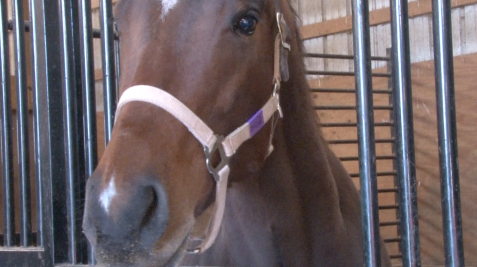WOODBINE — Hundreds of Maryland’s horses are homeless, abandoned by people who could not afford to care for them in the aftermath of the Great Recession.
Horse ownership increased in the decade prior to the economic downturn in 2009. But with the crash of the stock and housing markets, many owners were unable to afford the roughly $5,000 a year it takes to care for a horse.
“Horses, like all animals, suffered during the recession but horses, being so expensive, suffered the most,” said Valerie Pringle, equine protection specialist at the Humane Society of the United States. “There were many that were starving. People couldn’t afford to feed them. A lot of the rescues in Maryland had very heavy loads during the recession.”
Days End Farm Horse Rescue, a non-profit in Carroll County that rehabilitates abused and neglected horses, ran out of stall space in 2012 because it had taken in so many horses.

“During the recession we had many rescues that came in 300-400 pounds underweight,” said Caroline Robertson, director of development at Days End. “Horses are essentially the forgotten pet.”
Last month, new groundbreakings for single-family homes in the U.S. and the U.S. stock market reached historical highs, indicating that the economy is continuing to recover. But horse adoptions have not returned to pre-recession levels.
“As people have pulled out of the recession, horses have not,” Pringle said. “The number of horses being given up has decreased now, but people are not adopting horses at the rate they were before the recession.”
Caring for a horse requires disposable income.
Estimates from the Humane Society of the United States place horse maintenance, not including initial costs or rental fees, at more than $2,500 per year. This figure includes the cost of feed, hay and grains, veterinary and dental care, farrier services twice a year, bedding and vaccines. Depending on the location of the horse, boarding fees could cost an additional $3,600 per year.
The price of horse food has increased over the past decade, according to the Hay Price Index. The USDA Agricultural Prices report shows the price of hay per ton — $171 in November — has increased more than 200 percent since the 1990s. On average, horses eat 50 pounds — or $4.28 worth — of hay a day.

Valerie Ormond of the Maryland Horse Council said it’s difficult to track abused or neglected horses in Maryland, and nationwide. The equine industry is largely unregulated. So, precise figures are hard to gauge and it’s nearly impossible to determine number of horses that go to auctions, slaughters, fosters or elsewhere, Ormond said.
The Maryland Horse Council works with the Unwanted Horse Coalition—a broad alliance of equine organizations in Washington, D.C.—to try to identify statistical and geographical data on horses.
Based on a 2009 study, the group estimates that more than 170,000 “unwanted” horses are abandoned or otherwise neglected every year.
Aside from the financial burdens, many novice adopters aren’t ready for the time and energy commitment it takes to care for a horse, said Days End volunteer Katie Reed.
“People will just throw them in a field and not care for them,” Reed said. “We can’t save them all, we wish we could.”
The Unwanted Horse Coalition found that many of the critical national issues with horse abandonment were present in Prince George’s County.
The Prince George’s Equine Industry Task Force worked with the Unwanted Horse Coalition to create the Unwanted Horse Survey. The report introduced issues affecting the horse industry in the county.

Notably, the survey found Prince George’s County horse owners believed, “many people are unaware that most horse owners have been faced with the decision of selling, donating or euthanizing a horse.” Only twelve percent of horse owners surveyed said they had not yet experienced having to make one of those decisions.
“Horse owners reported that the general public and media do not fully understand the challenges in feeding, caring for, training and maintaining horses,” according to the survey.
As a private horse owner, Ellen Macks of Owings Mills, is familiar with the burdens of horse maintenance and care. Macks said the daily responsibilities of horse upkeep includes everything from exercise to monitoring their diets. Every horse has a different system and different needs, Macks said.
Despite their size, horses are incredibly fragile animals.
“Horses can’t regurgitate, so you have to make sure they don’t get a colic,” Macks said.
Additionally, horse teeth and hooves continue to grow throughout their lives. Their teeth can tear the inside of their mouths if they aren’t trimmed regularly, and improper hoof care can distort the structure of their feet.
“You need to be very, very careful about checking their systems,” Macks said.
Horses’ sensitive nature, fragility and mounting costs have all contributed to the inconvenient position they’re in today.The irony of the horses’ fate isn’t lost on Robertson, of Days End. Americans once depended on horses for survival.
“It’s interesting because they carried us in our wars, they supported us in our agriculture, they were our transportation for so many years,” Robertson said. “But now that we don’t need them for any of those things—we have engines, we have tanks to go into war—they don’t really have a purpose in society other than providing love and affection.”
But, the cost of that love and affection is out-of-reach for many families, still grappling to regroup from a poor economy.
“So, they’re having to reinvent themselves, and find their new place in society in the United States and the world,” Robertson added.


You must be logged in to post a comment.